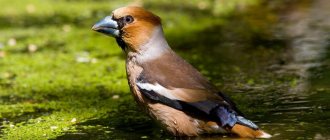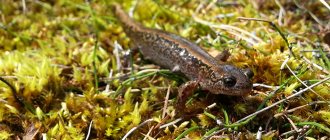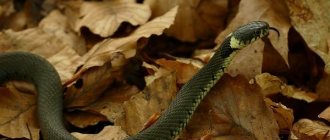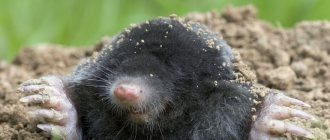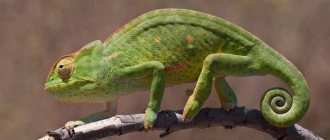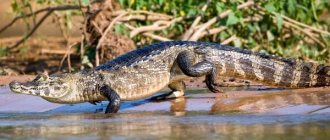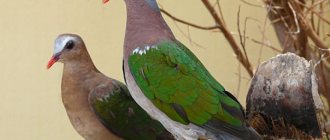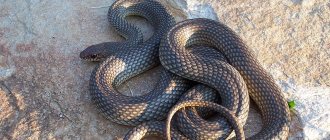- Wild animals
- >>
- Amphibians
Our land is inhabited by various amphibians. One of the most interesting representatives of this class of animals is the common newt n. This is a very small creature that ordinary people often confuse with toads and lizards. However, these are completely different species of amphibians, which do not have many common features. You can learn more about common newts, their external and behavioral characteristics in this publication.
Origin of the species and description
Photo: Common newt
Common newts are members of a large class of animals: “Amphibians.” This is a species of newt from the genus of small newts, which is considered one of the most numerous and widespread on the planet. In Latin, the name of the animal sounds like “Lissotriton vulgaris”. This species of animal was first noticed and described by Carl Linnaeus, a famous Swedish naturalist. And this happened back in 1758. Newts, including common ones, got their name in honor of the god Triton. This deity is usually depicted riding a dolphin, slightly submerged in the sea waves.
Video: Common newt
How to recognize and distinguish the common newt from other amphibians? This can be done based on several criteria. The common newt is very small. Its length rarely exceeds ten centimeters. Moreover, in ten centimeters, more than half is occupied by the tail. The skin of this newt is slightly grainy or completely smooth, colored olive green or brown with small dark spots. This species differs from its closest relatives, newts, by the presence of dark-colored longitudinal stripes on the head, which are located on the sides.
Interesting fact: The common newt, despite its rather cute appearance and small size, is dangerous for many animals. The skin of this amphibian secretes a deadly poison. The substance does not pose a threat to humans, but for many warm-blooded animals it can be fatal. Such a poison almost instantly eliminates all platelets in the blood, which leads to cardiac arrest.
The common newt is a tiny, not capricious and unpretentious creature. It is very popular among aquarists, so it is often kept at home. Keeping such an animal at home is not at all difficult. The main task of a person is to create and maintain the right conditions: lighting, soil, filling and size of the terrarium, nutrition. By providing suitable conditions, a person can get a cute pet that will live for at least twenty years.
Diseases
Like all amphibians, newts are sensitive to fluctuations in their habitat, and if the conditions are disrupted, diseases will not be long in coming. When purchasing a new animal, quarantine it, even if the animal looks healthy.
Newts are affected by various diseases. Some of them are related to the digestive system: intestinal obstruction (due to ingestion of soil), anorexia (under severe stress), parasites. The presence of helminths in the body of an amphibian can ultimately cause pneumonia.
Just like any aquarium inhabitants, newts are susceptible to fungal diseases: saprolegniosis, mucorosis. They can affect not only external tissues, but also internal organs.
One of the most common ailments of newts is the so-called “red leg”, or sepsis. This infectious disease is difficult to tolerate and occurs due to the entry of toxins or microbes into the blood. Another misfortune is dropsy. It manifests itself in the accumulation of fluid in the tissues of the animal, which occurs if the newt is not fed and maintained correctly.
When a newt ailment is detected, it is important to make a correct diagnosis. It is better to invite a specialist who, after assessing the animal’s condition, will prescribe competent treatment.
Appearance and features
Photo: Common newt in water
The common newt has a number of characteristic external features:
- small dimensions. The body length of this animal does not exceed ten centimeters - males are always slightly larger than females. Ten centimeters is taking into account the tail, which is at least half of the total length;
- smooth, less often – light-grained skin. Skin color can be brown or olive. The belly is always lighter than the back: yellow or light orange. There are dark spots on the body, and dark stripes on the sides on the head;
- well developed limbs. The newt has four legs of equal length. The front pair of legs has three or four fingers, and the back pair has five. The paws allow this animal to swim well and move along the bottom of the reservoir without problems. On land, common newts run a little clumsily;
- poor eyesight, but excellent sense of smell. Adults can recognize their prey from another two hundred meters away;
- conical teeth. They are located on the sky in two parallel rows. The teeth diverge slightly at a slight angle. This arrangement of teeth helps the animal hold the prey tightly in its mouth.
Interesting fact: Common newts have a unique feature - they can completely restore their internal organs, eyes or lost limbs.
Care
By following a number of rules and recommendations, caring for and breeding newts will not be difficult.
The following recommendations must be followed:
- The minimum amount of water per individual is 15-20 liters.
- Since newts are cold-blooded animals, sudden temperature changes in their habitat should not be allowed.
- The acidity of the water should not be higher than 8 PH, and the hardness should be within 10-12 dGH.
- For lighting, it is best to choose fluorescent lamps that will not heat the water.
- The stones in the aquarium should not be smaller than a newt's head. Otherwise, the pet will swallow them.
- It is important to maintain the correct water temperature for the amphibian, avoiding overheating.
Where does the common newt live?
Photo: Common newt in nature
Mixed, deciduous forests are suitable for the common newt to live in. These animals live and breed in stagnant or slow-moving bodies of water. On land they hide in bushes and can be found in parks, gardens, and forest belts. Open areas are avoided. The common newt is a very common creature. It lives almost everywhere. The only exceptions are some territories: Crimea, southern France, Portugal, Antarctica, Spain. The natural habitat depends on the subspecies of the common newt.
There are seven subspecies:
- Aretic. Lives in Greece, Macedonia, Albania and Bulgaria;
- Schmidtler's Triton. Found only in western Turkey;
- Ampelous. It is also called grape. It is distinguished by a low dorsal crest and lives in the north-west of Romania;
- Kosswig's Triton. He is also a resident of Turkey. You can meet such an animal on the southwestern coast;
- Lissotriton vulgaris vulgaris. This is a nominative species. Is the most common. Its natural habitat extends from Ireland to western Siberia. The differences of such an animal are a high dorsal crest, a pointed tip of the tail;
- Southern common newt. Its natural habitat is Slovenia, northern Italy, southern France;
- Triton Lanza. Lives in southern Russia, northern Armenia, Azerbaijan and Georgia.
Now you know where the common newt lives, let's see what it eats.
Spreading
Its habitat covers most of the European continent and the western regions of Asia. In the north it reaches Norway, Sweden and Finland, and in the west it reaches France and Great Britain.
The species is widespread in the countries of Central and Eastern Europe. In the south, the boundaries of the range pass through Serbia, Romania, Hungary, Moldova and Ukraine. In Russia, Tristatus cristatus is found mainly in the western part of the country up to Kazakhstan and partly in the Kurgan region in Southwestern Siberia.
The amphibian prefers to settle in lowlands. In mountainous areas it is observed at altitudes up to 700-850 m above sea level.
Today, taxonomists distinguish 4 subspecies based on the color, size and proportions of individual body parts. The most widespread is the nominate subspecies, covering the territory from France to the Urals and from Scandinavia to the Black Sea. It is characterized by an abundance of light spots on the sides and dark spots on the belly.
In Scandinavia, completely black individuals are often found.
The subspecies Tc carnifex is distributed in Italy, Austria, Serbia and Montenegro. It is characterized by a smoother skin and large gray spots on the abdomen. In females, a yellow stripe is often visible near the spine.
The subspecies Tc dobrogicus is found in the plain and Danube Delta. It is distinguished by its smallest size in comparison with its closest relatives. It has rough skin that is brown or reddish in color. On the ventral part of the body there are darkish spots in two rows.
Tc karelinii lives on the Balkan Peninsula and southwestern Russia. It is characterized by smooth skin and slight spotting with a bluish tint.
What does the common newt eat?
Photo: Common newt in Russia
Common newts are small but very agile creatures. They are excellent swimmers, their legs are mobile, they have fingers, which allows them to quickly move under the water at the bottom of the reservoir without any problems. These kids almost always hunt successfully. They can keep up with fast prey, and their acute sense of smell allows them to smell it even hundreds of meters away. In addition, common newts have a strong mouth with two rows of teeth. With its help, the animal easily holds its prey.
Interesting fact: It is quite difficult to distinguish a male from a female common newt. In normal times, the only difference is the size of the animal. Males are slightly larger than females, but even this is a subtle fact. However, during the mating season, gender differences are more pronounced. At this time, males develop a crest on their back.
The diet of the common newt includes:
- crustaceans;
- insect larvae and other invertebrates;
- fish caviar;
- tadpoles;
- slugs and earthworms;
- beetle larvae;
- oribatid mites;
- centipedes.
The most interesting thing is that newts have a much stronger appetite in water. On land they eat very little. Moreover, in water their stomach is almost ninety percent filled with water, and on land - only sixty-five percent. At home, the diet of animals is slightly different. Such amphibians are fed with earthworms, bloodworms, and aquarium shrimp.
However, you need to be very careful in keeping and feeding common newts. In particular, sand or very small pebbles should not be placed in the terrarium. While eating, an animal can swallow a grain of sand, and then there is a very high probability that the newt will die from intestinal obstruction.
Features of character and lifestyle
Photo: Common newt from the Red Book
Adult common newts lead both aquatic and terrestrial lifestyles. They have gills and lungs, which allows them to feel comfortable on land and in water. This natural property helps these animals survive during droughts, when the reservoir dries up. In general, the lifestyle of the common newt can be divided into two stages: winter, summer. In winter, the activity of the salamander representative becomes very small. Newts winter on land, looking for shelter for themselves in advance.
Even a simple pile of leaves will be suitable as a shelter for the common newt. But the best option is an abandoned hole. Quite often, newts spend the winter with their relatives. Wintering in a group increases the animals' chances of survival. There may be more than thirty adults in a group. When the ambient temperature drops below zero, newts freeze and stop moving completely.
Interesting fact: Few people know that common newts bring great benefits to people. These little creatures kill large numbers of mosquitoes. They eat them both as larvae and as adults.
In spring, even at temperatures below ten degrees Celsius, newts awaken after freezing and return to the water. The water is quite cold at this time, but newts tolerate this temperature well. In summer, common newts are active at night. They do not like bright light and are poorly adapted to heat. During the day you can see such an animal only during rain. Most often, newts live in small flocks, each of which contains about three to four adults.
Social structure and reproduction
Photo: Common newt underwater
The beginning of the mating season coincides with the moment of leaving winter shelters. As soon as common newts move back into the water in the spring, active mating games immediately begin. In reservoirs, the male and female gradually become closer and swim together. At this time, the representative of the stronger sex tries to hit his chosen one harder with his tail. Some time after such games, the animals mate.
The breeding season lasts a long time. During this time, the female newt manages to lay a huge number of eggs. Sometimes their number is in the hundreds and can reach seven hundred pieces. The female carefully camouflages each laid egg. She places it on a leaf of a plant that is immersed in water and bends it over. In this way she manages to create a kind of wallet. In it, the future offspring are reliably protected, because the folded leaf is held tightly due to the adhesive surface of the egg.
The process of testicular maturation stops only after fifteen days. Then larvae with a tail emerge from them. The length of the larva is approximately seven millimeters. The first day of its life the larva does not eat and even tries not to show itself in open spaces. Only on the second day does her mouth open, allowing her to begin feeding. After about three weeks the larva develops legs, and after two and a half months the larva develops into an adult common newt.
Interesting fact: In areas with warm climates, by autumn the larvae fully acquire the appearance of adults. In the north of their natural habitat, the larvae do not have time to go through all stages of development, so they still overwinter with external gills.
Courtship ritual
The male is waiting for the female in the pond. When a female appears, he approaches her, swims close, touches her muzzle, and sniffs her. Having made sure that there is a female in front of him, the male begins his dance. He moves forward and, finding himself in front of the female’s muzzle, makes a stance. For about ten seconds, the male stands on the bottom upside down, raising his body high and leaning only on his front paws. This is followed by a jerk, the male’s head remains almost in the same place where it was, the body lowers, the tail bends strongly and pushes the water directly onto the female. The male newt takes a break, and then, standing opposite the female, bends his tail and quickly hits himself with it. Then he stands, and the tip of his tail curls. The female begins to slowly walk forward, the male follows her.
Female
Natural enemies of common newts
Photo: Common newt in Russia
Common newts are small and practically defenseless creatures. They have the highest survival rate only in captivity. At home, these animals can easily reach twenty-eight years of age. In the wild, it is almost impossible to find an adult of this age. The average life expectancy in captivity for newts is only fourteen years. One of the reasons for such a big difference is the presence of a huge number of natural enemies.
The greatest number of enemies of newts lie in wait in the water. This is not surprising, because these amphibians spend a lot of time in bodies of water. Almost all species of animals living in water bodies are not averse to feasting on common newts.
The worst enemies include:
- immediate family. Despite their direct relationship, larger newts eat small ones. For example, crested newts are often seen doing this;
- frogs. Amphibians are excellent hunters. For them, newts are very easy prey;
- fish Perch, pike, carp and many other fish attack adult amphibians or feast on their larvae;
- snakes and vipers. They deftly catch visually impaired newts and swallow them almost whole;
- birds and some animals living on land. Common newts rarely appear on earth. But if they go out there, they become easy prey for some animals and birds, because on the ground newts are very clumsy. Water voles, gray herons, and mallards are not averse to eating them.
However, not all common newts are defenseless. Many subspecies have very toxic skin. For example, the yellow-bellied newt contains enough poison on its integument to kill twenty-five thousand small rodents.
Compatibility
Unfortunately, having made a choice in favor of newts, every aquarist should know that this amphibian will not get along with fish for the following reasons:
- Different content requirements.
- Many amphibians secrete toxic mucus that will harm the fish.
- Most species are aggressive.
But if the owner really wants to diversify the aquaterrarium, then you can add the following to the newts:
- Medium-sized calm fish, such as platies.
- Medium-sized catfish with a calm disposition.
- Large ampularia or aquarium hymenochirus frogs.
Population and species status
Photo: Common newt
Common newts have a high level of fertility. In one mating season, females are capable of laying about seven hundred eggs. In most areas of their natural habitat, this property allows animals to maintain a stable population level. However, even high fertility in some areas could not save the situation, and today in many countries the population of the common newt has greatly decreased.
What is the reason for the sharp decline in the number of these amphibians?
There are several main ones:
- short life expectancy. In captivity, a newt lives no more than fourteen years. There are many reasons for this. The most significant are lack of food, drought and vulnerability to natural enemies. Common newts are very small, have poor health, poor eyesight, and are very clumsy on land. All this makes them easy targets;
- pollution of water bodies. Dirty water, a huge amount of waste - all this deprives animals of their home and food;
- geographic and climatic changes in some areas of the natural habitat. Many reservoirs are being drained and gradually disappearing. Climate change is also negatively impacting the newt population. These animals are poorly adapted to heat.
Reviews
Newts are considered low-maintenance animals and can be kept at home. The main thing is to create the right living conditions. Do not forget that representatives of salamanders crawl excellently on vertical surfaces. Therefore, you should select an aquarium with a lid so that the amphibian cannot escape and die from dehydration.
Did you learn something new? Share in the comments!
